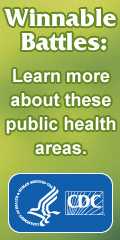March 2014
Did You Know? is a weekly feature from the Office for State, Tribal, Local and Territorial Support to inform your prevention activities. We invite you to read, share, and take action!
View the Current Did You Know?
March 28, 2014
- Excessive alcohol use is a leading preventable cause of death and cost states a median of $2.9 billion in 2006, or about $1.91 per drink.
- Increasing alcohol taxes is an effective strategy for reducing excessive drinking; a 10% increase in the price of alcohol could reduce alcohol consumption by 7%.
- You can find your state’s rating for excise taxes on beer, distilled spirits, and wine in CDC’s Prevention Status Reports.
March 21, 2014
- Worldwide, 780 million people live without safe drinking water and 2.5 billion live without basic sanitation, which are leading causes of diarrheal diseases. Diarrheal diseases account for 1 in 9 child deaths worldwide.
- Diarrhea prevention focused on safe water and improved hygiene and sanitation is cost effective: every $1 invested yields an average return of $25.50.
- You can learn more about global safe water efforts from CDC’s fact sheets, podcasts, and videos.
March 14, 2014
- Deep vein thrombosis and pulmonary embolism—together known as venous thromboembolism [PDF–357KB]—affect 300,000–600,000 individuals in the US each year, and at least 1 in 10 die.
- Deep vein thrombosis and pulmonary embolism are often underdiagnosed and are serious but preventable medical conditions. Help others learn about the risk factors, signs, and symptoms.
- Learn what CDC is doing [PDF–1.2MB] about venous thromboembolism.
March 7, 2014
- Doctors in some hospitals prescribed up to 3 times as many antibiotics as doctors in similar areas of other hospitals, according to a newly released study of antibiotic prescribing practices in a sample of US hospitals, based on 2010 data.
- Reducing the use of high-risk antibiotics by 30% can lower C. difficile infections by 26%.
- State health departments can help hospitals develop antibiotic stewardship programs by facilitating the use of the CDC self-assessment checklist and an in-depth implementation tool.
Did You Know? information and web links are current as of their publication date. They may become outdated over time.
- Page last reviewed: November 9, 2015
- Page last updated: October 14, 2016
- Content source:



 ShareCompartir
ShareCompartir



